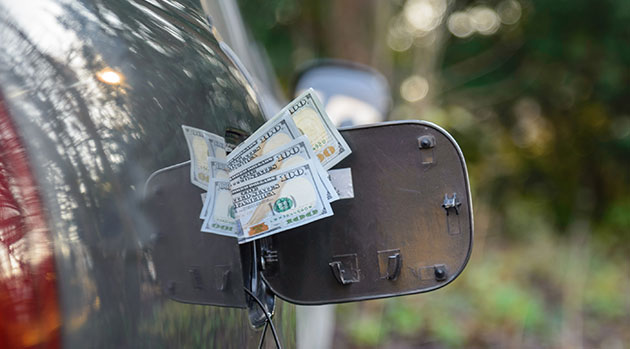In an era of rising temperatures, both political and weather-wise, one might catch some heat for driving a “gas guzzler.”
The automotive energy source is tightly tied to an industry blamed for a malevolent gamut that runs from toxifying the environment to instigating civil and foreign war. Yet for all its pitfalls and public image problems, the petroleum-based product has steadily contributed to at least one societal benefit: the gas tax, a tariff largely responsible for the maintenance and safety of roads, tunnels, and bridges.
But just like the oil gasoline is derived from, it seems the fuel’s fundraising potential has passed peak production.
Major countries around the world have put the combustion engine in their crosshairs and pledged to prioritize the fuel efficiency of new vehicle models. Combined with the rise of autonomous autos, the trends seem to indicate an increasingly electric future for driving.
Without the reliable slow-drip of a gas tax, most states’ transportation reserves would run dry, and the coming improvements to auto efficiency have already sent many running to explore new revenue streams.
Still, pumping the public for additional tax dollars is difficult, unpopular, and almost always unwelcome.
As the levy on gas continues to lose steam, can we find an alternative fuel source to power our infrastructure?
Monetary Makeover
The gas tax has been around nearly as long as gas-powered cars. Oregon lawmakers created the first official levy on the commodity in 1919—and ever since, the charge has played an important role in keeping government coffers full.
“The gas tax is the cornerstone of our transportation and infrastructure funding,” said Carl Davis, Research Director at the Institute on Taxation and Economic Policy (ITEP). “It’s the main source for those projects and it has been for a long time.”
But just because the tax has become an institution doesn’t mean it’s aged well.
“A lot of gas taxes are poorly designed, and that’s part of the problem,” Davis said. “It’s not that the gas tax is bad and we need to get rid of it, but it’s a sign that the states haven’t designed it very well.”
And they get little help from federal legislators, who have been loath to approve funding for infrastructure projects for years and have kept the national gas tax rate flat for decades—although Congress is now considering the first increase since 1993.
“It’s not able to keep up with the costs of building bridges and paving roads and servicing transit—but that’s more to do with inflation than fuel efficiency,” Davis said of the national rate. “Asphalt has become more expensive, machinery has become more expensive, labor has become more expensive, time has become more expensive, and fuel efficiency has started to chip away at it.”
To keep up with those perpetually rising prices on an increasingly battery-powered road, states need to consider fees that likewise have some financial flexibility, Davis said. He pointed to the new system implemented in Georgia this year, which bases the gas tax rate on several factors, including the average fuel efficiency of the cars registered in the state each year. (The legislation calls for the rate to be recalculated on an annual basis.)
Other states have also toyed with tying fuel efficiency to fees, including Missouri, which is currently contemplating a vehicle registration fee determined by the number of miles a car gets per gallon, instead of its horsepower.
For Davis, the idea is a step in the right direction.
“If [hybrids] are not chipping in more for gas taxes, they can at least chip in with registration for their wear and tear on the roads,” he said. “I’ve seen a lot of states dip into their general revenue funds instead to cover the projects, but that can be problematic if a state is already falling short for funding in other areas. It’s often used as a Band-Aid.”
But a clutch of other states prefer a more proactive approach to the problem and are currently preparing to rip off the financial bandage.
Go Your Own Way

In the annals of gas tax history, Oregon plays a seminal role. The state not only introduced the levy; it now may well be pioneering its next iteration: mileage-based fees.
The Beaver State has tracked—and charged for—some residents’ roadway usage since 2015 through a pilot program called OreGO. Participating drivers keep tabs on their mileage and pay a flat tax fee—1.5 cents per mile—on their annual total.
“The idea of the road charge program is it evens the playing field again,” said Michelle Godfrey, a representative of the Oregon Department of Transportation. “Where some vehicles were paying very little in gas taxes and others were paying more, the road charge system charges drivers for what they use.”
Key in the experiment is the accurate tracking of miles, which most motorists achieve through the use of a GPS. (Drivers in the pilot are given a choice between using the electronic devices or manually tabulating mileage, but “better than 75% of participants” have chosen the GPS, Godfrey said.)
The device is kept in participants’ vehicles and, aside from keeping tabs on roadway usage, offers additional features, like monitoring driving behavior. But even with its extra bells and whistles, the digital aid makes some drivers wary.
“It’s a very controversial topic,” Godfrey said. “People are very concerned about privacy. Evolving the technology is important to us looking into the future.”
Still, thanks to rapid advances in transportation technology, she said—and evermore connected roads—such tracking devices may soon not be needed at all. And that change could come even more quickly thanks to growing interest in the idea, and especially its increasing popularity in the Pacific Northwest.
Washington State is set to start a similar pilot program for mileage levies next year, and California recently wrapped up its own road usage taxation experiment. Meanwhile, Oregon has already opened discussions with its southern neighbor about launching a joint initiative to see how miles can be tracked across state lines, Godfrey said.
But while the West Coast focuses on future ways to reap tax dollars for road repair, the East Coast has zeroed in on ways to see greater profits today.
Fare & Square
New York has long been famous as the home of big yellow taxis, but when rideshare vehicles moved into town, the state made sure they paid for the pleasure.
The on-demand businesses aren’t just a boon to Silicon Valley; they’re a financial outlet for states to recoup some funding lost on dwindling gas tax returns. Imposing sales tax alone on the rides would create $300 million in annual revenue for local and state governments, ITEP estimated earlier this year.
Few states have so far seized the opportunity, with sales tax on the rides only imposed in Maryland, Massachusetts, Nevada, Pennsylvania, South Carolina, and New York.
Still, with different laws in upstate and New York City showing how different tax plans can impact the budget, the Empire State offers various views of how the rideshare tax idea could be implemented.
New York City collects an 8.875% sales tax from each app-based ride, with about half that amount going to the state and the other collected by local municipalities. While ridesharing networks are still being shoehorned into the tax code and official numbers remain scattered, the fee could have reasonably raised more than $200 million for the local government over a period of less than two years, according to the New York Times. (Each municipality has its own rules governing how funds collected from sales tax can be spent.)

The separate rollout of ridehailing upstate is anticipated to bring an additional $24 million to New York’s coffers each year, but in that case, all the money will go directly to the state. That’s because the 4% fee imposed on upstate rideshare companies is officially an “assessment,” representing only the state’s cut, rather than a sales tax, which includes additional transportation fees sent to local municipalities. And while legislators attempted to sanction a piece of that 4% charge for transportation-specific projects around the state, the idea didn’t survive the legislative process.
“My assumption was that some legislators saw this as a way to help the state and possibly local jurisdictions fund transit programs by having this new source of revenue that was not available before, but was related to transportation,” said Joshua Lawrence, a New York tax attorney who worked on a state rideshare tax report. “But they couldn’t agree in the end on where the money should go, so as far as the legislation goes, it’s not designated to any specific use.”
Instead, the rideshare “assessments” are allocated to the state’s general fund—where they can be used to cover any cost, like the financial Band-Aid described by ITEP’s Carl Davis.
Still, Davis noted, with so much work to do on the roads, every dollar is welcome—regardless of where it comes from.
“It’s good to be talking about vehicle miles traveled and other taxes, but we shouldn’t forget about the revenue source we have today,” Davis said. “We have bridges and tunnels that need to be fixed now, and if we’re going to do that, we’re going to need the gas tax.”
“We’re in a period of transition, and there’s definitely room for improvement and reform, but right now, I think the gas tax still works pretty well.”
